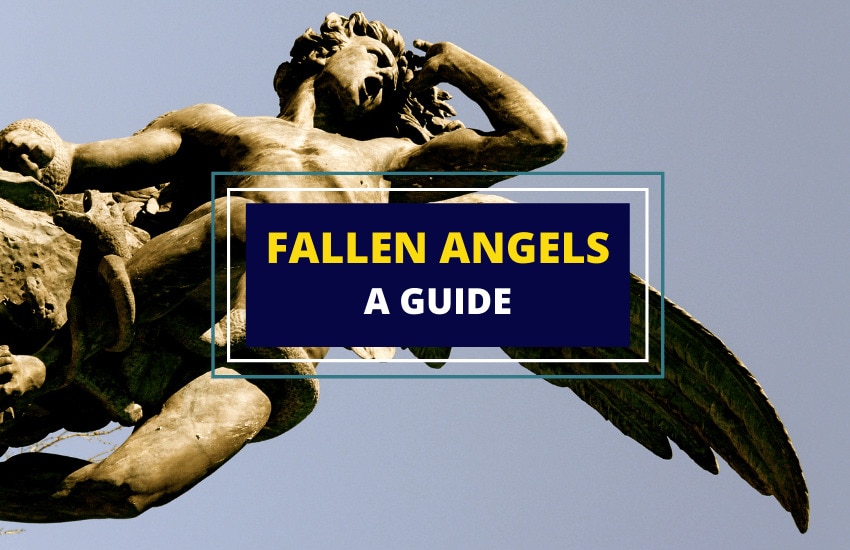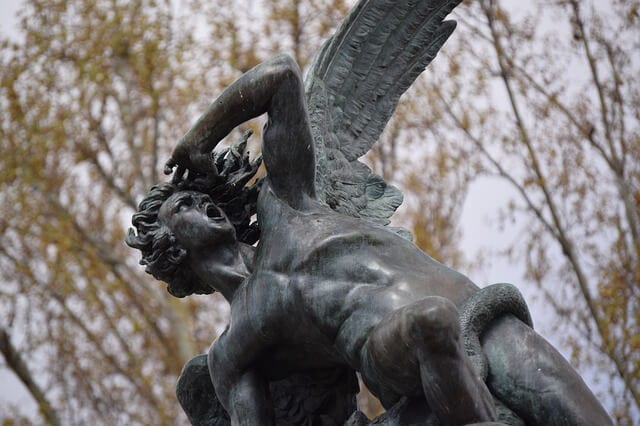
Table of Contents
The topic of fallen angels is primarily related to the Abrahamic religions of Judaism, Christianity, and Islam. The term “fallen angel(s)” does not appear in any of the primary religious texts of those religions. The concept and beliefs derive from indirect references in both the Hebrew Bible and Quran, more direct references in the New Testament, and direct stories recounted in some intertestamental pseudepigraphal writings.
Fallen Angels Mentioned in Primary Texts

This is a listing of the primary texts concerning the doctrine of fallen angels with a brief explanation of each.
- Genesis 6:1-4: In verse 2 of Genesis 6, a reference is made to the “sons of God” who saw the “daughters of men” and were so attracted to them that they took them for wives. These sons of God were believed to be angels who rejected their supernatural positions in heaven in favor of following after their sexual desire for human women. The women bore offspring from these relationships and these offspring are known as the Nephilim, referred to in verse 4. They are believed to be a race of giants, half human, and half angel, who lived on earth prior to the flood of Noah, described later in chapter 6.
- Book of Enoch: Also referred to as 1 Enoch, this writing is a pseudepigraphal Jewish text written during the 4th or 3rd centuries BCE. It is the detailed description of the traveling of Enoch from earth through the various levels of heaven. The first section of Enoch, The Book of Watchers, expounds upon Genesis 6. It describes the fall of 200 “watchers” or angels who take for themselves human wives and beget the Nephilim. We are given the names of the twenty leaders of this group and are told how they also taught humans certain knowledge which led to evil and sin in the world. These teachings include magic, metal working, and astrology.
- Luke 10:18: In response to his followers’ statement concerning supernatural authority given to them, Jesus says, “I saw Satan fall like lightning from heaven”. This statement is often connected to Isaiah 14:12 which is often understood to describe the fall of Satan, who was once a high-ranking angel known as the “Day Star” or “Son of Dawn”.
- Revelation 12:7-9: Here we have described in apocalyptic language the fall of Satan. He is depicted as a great dragon who seeks to kill the messianic child born of a heavenly woman. He fails in this attempt and a great angelic war ensues. Michael and his angels battle against the dragon and his angels. The defeat of the dragon, identified as Satan, results in him and his angels being cast down out of heaven to earth where he seeks to torment God’s people.
- Other references to fallen angels in the New Testament include 1 Corinthians 6:3, 2 Peter 2:4, and Jude 1:6. These passages refer to the judgment of angels who sinned against God.
- Quran 2:30: Here is told the story of the Fall of Iblis. According to this text, the angels protest against God’s plan to create humans. The basis of their argument is that humans will practice evil and unrighteousness. However, when God demonstrates the superiority of man over the angels, he orders the angels to prostrate themselves before Adam. Iblis is the one angel who refuses, continuing to boast of his own superiority over Adam. This leads to him being expelled from heaven. There are other references made to Iblis in the Quran including Surrah 18:50.
Fallen Angels in Doctrine
The Book of Enoch was written during the time known as the Second Temple Period of Judaism (530 BCE – 70 CE). Other intertestamental pseudepigrapha also written during this time include 2 and 3 Enoch and the Book of Jubilees.
These works all describe to some degree the activity of fallen angels based on the primary texts of Genesis and 1 Enoch. By the 2nd century CE, rabbinic teaching had largely turned against the belief in fallen angels in order to prevent their veneration.
Most teachers rejected the idea that the sons of God were in fact angels, and the intertestamental texts did not survive in the Jewish canon beyond the 3rd century. Over the centuries, the belief in fallen angels re-merges from time to time in Midrashic writings. There is also some reference to evil, though not explicitly fallen, angels in Kabbalah.
In early Christian history there is evidence of widespread belief in fallen angels. Agreement with the interpretation of sons of God being fallen angels persists among the church fathers beyond the second century.
References to it are found in the writings of Irenaus, Justin Martyr, Methodius, and Lactantius among others. The divergence of Christian and Jewish teaching on this point can be seen in the Dialogue of Justin With Trypho. Trypho, a Jew, is quoted in chapter 79, “The utterances of God are holy, but your expositions are mere contrivances… for you assert that angels sinned and revolted from God.” Justin then proceeds to argue for the existence of fallen angels.
This belief begins to wane in Christianity by the fourth century. This is primary due to the writings of St. Augustine, particularly his City of God. He changes direction from focus on the sons of God in Genesis, to an emphasis on the fall of Satan. He also reasons that because angels are not corporeal, they cannot have sinned in the area of sexual desire. Their sins rather are based upon pride and envy.
During the middle ages, fallen angels appear in some of the most well-known literature. In Dante’s Divine Comedy, fallen angels guard City of Dis which is a walled area comprising the sixth through ninth levels of hell. In Paradise Lost, written by John Milton, fallen angels are living in hell. They have created their own kingdom named Pandaemonium, where they maintain their own society. This aligns with a more modern concept of hell as a place ruled by Satan and the abode of his demons.
Fallen Angels in Christianity Today
Today, Christianity in general rejects the belief that the sons of God were in fact fallen angels whose offspring became demons.
Within Roman Catholicism, the fall of Satan and his angels based upon the description in Revelation is the belief held and taught. It is viewed as a rebellion against the authority of God. Protestants by and large hold to this same viewpoint.
The only known Christian group to still hold to the earlier teaching is the Ethiopian Orthodox church, who also still use the pseudepigraphal works of Enoch.
The concept of fallen angels has been heavily debated in Islam from its beginning. There are reports of some of the Prophet Mohammed’s companions giving ascent to the idea, but it was not long before opposition to this arose.
Based upon texts from the Quran, early scholars, including Hasan of Basra, rejected the idea that angels could sin. This led to the development of belief in angels as infallible beings. In the case of the Fall of Iblis, scholars debate whether Iblis himself was even an angel.
List of Fallen Angels
From the various sources sited, the following list of the names of fallen angels can be compiled.
- Old Testament
- “Sons of God”
- Satan
- Lucifer
On the differences between the names Satan and Lucifer, see this article.
- Paradise Lost – Milton took these names from a combination of ancient pagan Gods, some of which are named in the Hebrew Bible.
- Moloch
- Chemosh
- Dagon
- Belial
- Beelzebub
- Satan
- The Book of Enoch – These are the twenty leaders of the 200.
- Samyaza (Shemyazaz), the head leader
- Araqiel
- Râmêêl
- Kokabiel
- Tamiel
- Ramiel
- Dânêl
- Chazaqiel
- Baraqiel
- Asael
- Armaros
- Batariel
- Bezalie
- Ananiel
- Zaqiel
- Shamsiel
- Satariel
- Turiel
- Yomiel
- Sariel
In Brief
The belief in fallen angels can be found to have common threads throughout the religions in the Abrahamic tradition, from 2nd Temple Judaism to the early Church Fathers to the beginnings of Islam.
In some form, this belief forms the basis for understanding the existence of good and evil in the world. Each of the traditions have dealt with a doctrine of angels both good and evil in their own way.
Today the teachings on fallen angels are based primarily on a rejection of God and his authority and serve as a warning to those who would do the same.








